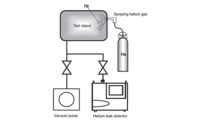There are numerous applications for helium, automatic leak test systems (ALTs) in the automotive components assembly process. These applications presently include the leak testing of: tire rims, condensers, heat exchangers, evaporators, transmissions, braking systems, fuel tank systems, torque converters, air bag inflators, catalytic converters, compressors, shocks, oil pans and muffler/silencers. There is a large range of automotive components and sub-assemblies that require leak testing.
Historically, leak testing methods for these components have included: water immersion, compressed air and halogen leak testing. A current solution to high volume component/part leak testing is automatic leak test systems that use helium and a helium leak detector. By using this type of system, human error and environmental issues can be eliminated. ALT systems are highly accurate and reliable. ALT systems are currently available in a wide variety of sizes and chamber configurations, and can operate in three different modes. Examples of these different types are shown throughout this article.
Although there are numerous chamber /system configurations for ALT Systems, the basic design is depicted in Figure 2.
ALT systems can operate in three different methods/modes. The first mode (ALT-1) is by using the external pressure method on the workpiece. The second (ALT-2) is by using an internal method on the workpiece. The third (ALT-3) involves employing a “sniffer.” The sniffer method involves pressurizing helium gas inside a workpiece and detecting the presence of helium gas from outside the workpiece. The different modes for ALT systems are described below:
The ALT-1 series of automatic leak test systems performs leak testing by using the external pressure method. This method involves pumping air out of the workpiece (test object) to create a vacuum, spraying helium gas onto the outside of the workpiece and then detecting if helium gas enters the workpiece with a helium leak detector. Figure 3 depicts the operating schematic for this mode of operation.
The ALT-2 Series of automatic leak test systems performs leak testing by using the internal method. This method involves injecting helium gas inside the workpiece in a vacuum chamber, pumping out the vacuum chamber to create a vacuum, and then detecting whether helium leaks from the workpiece into the vacuum chamber with a helium leak detector. Figure 4 depicts the operating schematic for this mode of operation.
The ALT-3 series of automatic leak test systems performs leak testing by employing the “sniffer” method. The sniffer method involves pressurizing helium gas inside the workpiece and detecting the presence of helium gas from outside the workpiece. Figure 5 depicts the operating schematic for this mode of operation.
Helium leak testing, which uses helium gas to measure (detect) leaks, is considered the best leak test method currently available. For leak testing of automotive components manufactured in high volumes, it has some disadvantages in that it requires larger equipment (multiple leak test chambers), costs more, and consumes more energy than water immersion testing and air leak testing. To remedy these disadvantages, there are new developments in helium leak testing, with leak testers that use a mechanism for analyzing high-speed gas in evacuation, to realize high accuracy, high-speed, energy saving, and environmentally-friendly leak testing.
Figure 6 depicts a diagram of the mechanism for analyzing high-speed gas in evacuation.
In figure 6, helium gas is injected into a test object (in the helium injection position). Then the test object is loaded into a test chamber. A new type of helium leak detector is installed via a helium gas collecting mechanism in the middle of an evacuation pipe of the test chamber. The detector measures helium gas molecules flowing into the test chamber evacuation pipe to check for leaks from the test object.
Unlike conventional methods that measure helium gas by evacuating a test chamber to about 5 Pa, switching valves to connect the chamber to a helium leak detector, and using free diffusion of helium gas, this method has enabled connection of a helium leak detector under low vacuum conditions through the development of a mechanism for analyzing high-speed gas in evacuation, which actively takes in gas flowing through the evacuation pipe.
There are several benefits of using this type of apparatus. Test objects are quickly replaced on a rotary table by simultaneously injecting helium gas into one test object and conducting a leak test on another in a different location.
By reducing the cycle time per chamber, the number of chambers required to assure performance of a tester has been reduced from two to one, leading to significant cost reduction.
By reducing the number of chambers, accessibility has been improved, contributing to the improvement in work efficiency and reduction in labor costs.
This new method assures performance under low vacuum condition (about 100 Pa) and thus requires fewer evacuation (vacuum) pumps, contributing to energy savings.
The reduction in the number of chambers and vacuum pumps contributed to the system’s footprint by about 45% compared to conventional testers.
Progress of the automatic operation process and values measured by measuring instruments, such as the degree of vacuum, pressure, and helium concentration, are collectively displayed on a single screen to make the tester status and the judgment of results visible at a glance to the operator.
In the automotive industry there is a high degree of component/assembly reliability required. There are also many more components and assemblies that require leak testing. Old methods of leak checking are very unreliable and labor intensive. This has lead to the dominance of automatic leak test systems, which are proliferating rapidly, and being configured in rapidly increasing form factors.
TECH TIPS
The automotive industry involves many components and assemblies that require leak testing.
Previous methods of leak checking are very unreliable and labor intensive.
This has lead to the dominance of automatic leak test systems, which are being configured in rapidly increasing form factors.









